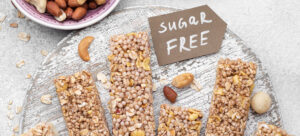Are you a fan of granola bars? These crunchy delights are perfect for a quick breakfast, a mid-day snack, or even a dessert. Granola bars come in a variety of flavours and textures, making them a versatile and satisfying snack option. In this complete guide, we will explore everything you need to know about granola bars, from their history to their nutritional value, and even provide some delicious recipes for you to try at home.
Granola bars were first invented in the late 1800s as a healthy and portable snack for hikers and travelers. Since then, they have become a popular snack option for people of all ages and lifestyles. Granola bars come in a variety of flavours, from classic oat and honey to chocolate chip and peanut butter. They can also be made with a variety of ingredients, including nuts, seeds, dried fruit, and even chocolate.
In addition to being a tasty snack, granola bars can also provide a range of nutritional benefits. They are often high in fiber, protein, and healthy fats, making them a filling and satisfying snack option. However, not all granola bars are created equal, and it’s important to choose bars that are low in sugar and free from artificial ingredients. In the following sections, we will explore the nutritional value of granola bars in more detail and provide some tips for choosing the healthiest options.
The History of Granola Bars
Granola bars have become a popular snack for people on the go. They are easy to carry, filling, and provide a quick energy boost. But have you ever wondered where this delicious snack originated?
The first granola bar was created in the 1970s by health food store owners in California. It was a simple combination of rolled oats, nuts, and honey, and was intended to provide a healthy, portable snack. The concept of granola bars quickly caught on, and soon the snack was being sold in stores all over the country.
However, the idea of granola itself goes back much further. The word granola is derived from the Latin word for grain, and it is believed that the combination of oats, nuts, and honey was first made by a doctor in the United States in the late 1800s. Granola has since become a popular breakfast food, as it is both filling and nutritious. It is also a great way to add extra nutrition to other dishes such as yogurt and smoothie bowls.
Over the years, granola bars have evolved to include a variety of flavors and ingredients. Today, you can find granola bars that are gluten-free, vegan, and even paleo-friendly. Some granola bars are made with chocolate chips, dried fruit, or even peanut butter. No matter your dietary restrictions or taste preferences, there is likely a granola bar out there that you will enjoy.
Nutritional Benefits of Granola Bars
Granola bars are a popular snack food that can provide a variety of nutritional benefits. In this section, we will explore the macronutrients, vitamins, minerals, and dietary fiber that granola bars contain.
Macronutrients in Granola Bars
Granola bars generally contain a balance of macronutrients, including carbohydrates, protein, and fat. The exact amount of each macronutrient will depend on the specific type of granola bar you choose. For example, some granola bars may be higher in protein and lower in carbohydrates, while others may be higher in carbohydrates and lower in protein.
Vitamins and Minerals
Many granola bars also contain a variety of vitamins and minerals. For example, some granola bars may be fortified with B vitamins, which are important for energy production and brain function. Other granola bars may contain calcium, which is important for bone health, or magnesium, which is important for muscle and nerve function.
Dietary Fiber and Its Advantages
One of the main benefits of granola bars is that they are a good source of dietary fiber. Fiber is important for digestive health and can help regulate blood sugar levels. Many granola bars contain both soluble and insoluble fiber, which can help keep you feeling full and satisfied between meals.
Making Granola Bars at Home
Granola bars are a great snack to have on hand when you’re on the go or just need a quick pick-me-up. Making your own granola bars at home is not only more affordable but also allows you to customize them to your liking. Here’s a guide to making granola bars at home.
Choosing the Right Ingredients
The first step in making granola bars is choosing the right ingredients. You can use a variety of ingredients to make granola bars, including oats, nuts, seeds, dried fruits, and sweeteners. When choosing your ingredients, make sure to opt for high-quality, organic ingredients whenever possible.
Here are some common ingredients used in granola bars:
- Rolled oats: Rolled oats are the base ingredient for most granola bars. They provide a chewy texture and are a good source of fiber.
- Nuts and seeds: Nuts and seeds add crunch and flavor to granola bars. Some popular options include almonds, cashews, peanuts, sunflower seeds, and pumpkin seeds.
- Dried fruits: Dried fruits add sweetness and chewiness to granola bars. Some popular options include raisins, cranberries, cherries, and apricots.
- Sweeteners: Sweeteners such as honey, maple syrup, and brown rice syrup are used to bind the ingredients together and add sweetness to the bars.
Step-by-Step Baking Guide
Now that you’ve chosen your ingredients, it’s time to start baking. Here’s a step-by-step guide to making granola bars at home:
- Preheat your oven to 350°F (175°C). Line a baking sheet with parchment paper.
- In a large bowl, mix your dry ingredients, including rolled oats, nuts, seeds, and dried fruits.
- In a separate small bowl, mix your wet ingredients, including your sweetener of choice and melted coconut oil or butter.
- Pour the wet ingredients into the dry ingredients and mix until everything is evenly coated.
- Spread the mixture evenly onto the prepared baking sheet and press down firmly with a spatula.
- Bake for 20-25 minutes, or until the edges are golden brown.
- Remove from the oven and let cool completely on the baking sheet.
- Once cool, cut the granola into bars or squares.
Making granola bars at home is a simple and rewarding process. With these tips and tricks, you can create delicious and healthy granola bars that are perfect for snacking on the go.
Commercial Granola Bars
If you’re looking for a quick and easy snack on the go, commercial granola bars are a great option. They come in a variety of flavours and textures, making it easy to find one that satisfies your cravings. However, with so many options on the market, it can be hard to know which ones are the best for you. In this section, we’ll take a closer look at the top brands and their offerings, help you understand food labels, and discuss the role of preservatives.
Top Brands and Their Offerings
Some of the most popular granola bar brands include KIND, Nature Valley, and Quaker. KIND bars are known for their simple ingredients and unique flavours, such as Dark Chocolate Nuts & Sea Salt and Almond Butter Dark Chocolate. Nature Valley offers a wide variety of crunchy granola bars, including Oats ‘n Honey and Peanut Butter. Quaker offers Chewy bars in flavors like Chocolate Chip and Peanut Butter Chocolate Chip.
Conclusion
Granola bars are a convenient and nutritious snack that offer a balanced mix of macronutrients – carbohydrates, protein, and healthy fats – as well as essential vitamins, minerals, and dietary fiber. This combination makes them a satisfying and filling snack that aids in digestive health, regulates blood sugar levels, and supports overall well-being.
To choose the right granola bar, it’s important to be mindful of the quality of the ingredients and opt for bars with low added sugars, whole grains, and higher fiber content. While commercial options provide convenience, making homemade granola bars allows for customization and ensures control over ingredients and sweetness levels.
If you’re looking for quick breakfast, a mid-day snack, or a dessert alternative, the rich history, nutritional benefits, and wide-ranging flavors of granola bars make them a delightful and adaptable choice. Top brands like KIND, Nature Valley, and Quaker offer a multitude of options, but it’s important to understand food labels and be aware of preservatives to make informed choices aligned with your health goals and dietary preferences.





